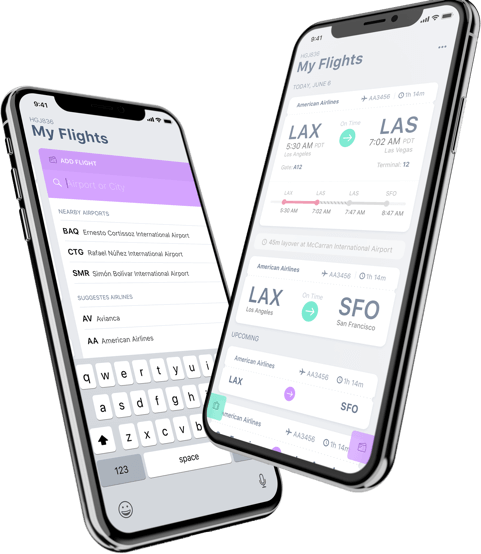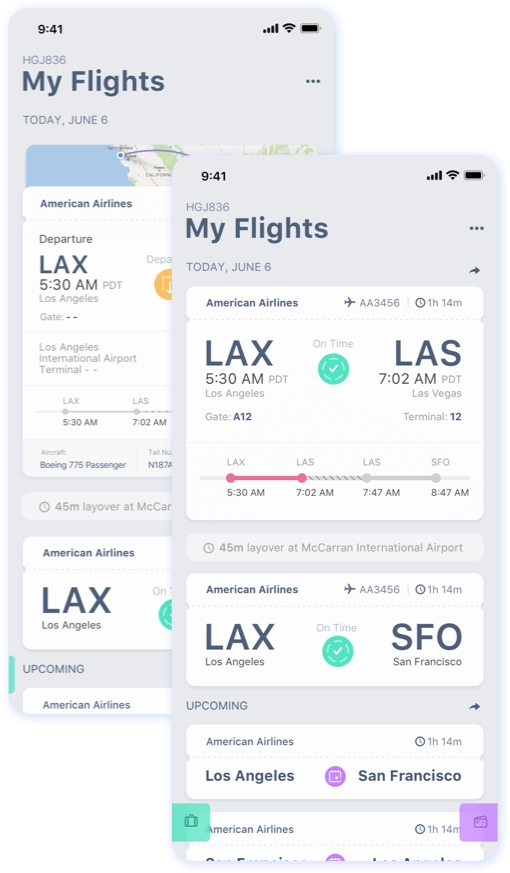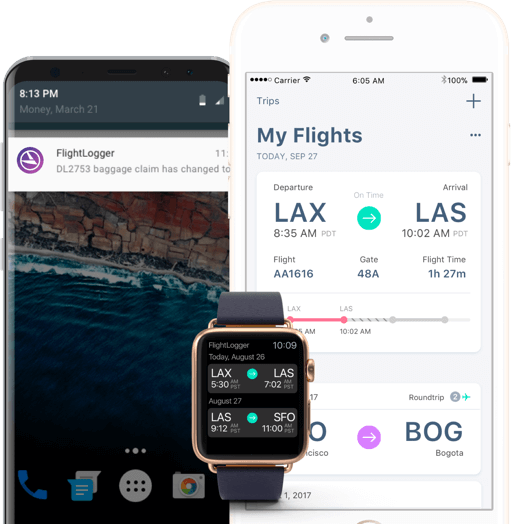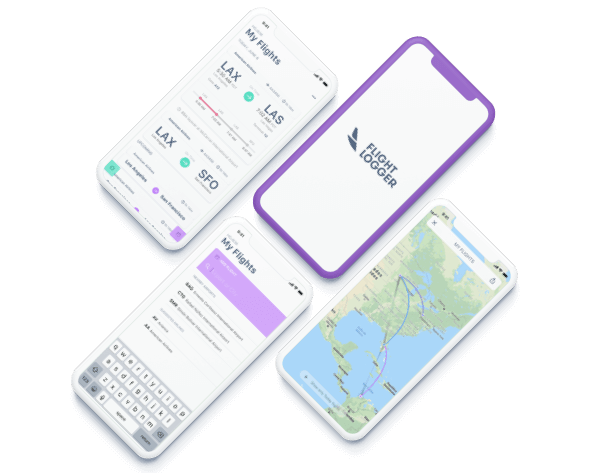Technologies
Category
HiTechDevices
iOSExpertise
Mobile AppMeet Flightlogger
FlightLogger is a popular app for iOS and Android. With their real-time flight tracking technology, they offer worry-free traveling. FlightLogger takes the guesswork out of traveling by offering up to the minute details of flight delays and changes which facilitates the arrangement of airport pickups.
Using FlightLogger, friends, and family can track flights of their loved ones. The app also has a handy feature that allows users to forward their flight information to the app and FlightLogger will automatically add it to the itinerary saving users a ton of time.
The design of the app is clean, sleek and clutter-free making it easy to use and simple to view all flight information.
FlightLogger is free to download, however, some of its features are premium. The premium subscription is available for $1.99/month or $14.99/year.
Where FlightLogger Fits into the Marketplace

As tech-driven people, we are always trying to manage every aspect of our daily lives through technology and avoid wasting time whenever possible. Since the team at Koombea travels frequently, as a result of having clients all over the world, we knew that an app like FlightLogger would do well in the app marketplace.
Here at Koombea, we realized that FlightLogger would stand out and succeed with its advanced vision.
FlightLogger Challenges that Koombea Solved
One of the most challenging features of FlightLogger was to create an easy way to show flight itineraries in the form of a timeline. It might sound like an easy task, but we had to consider the different time zones and those cases when a flight departs on one day and arrives the next day. There were too many edge cases that were breaking the most common rules, so we had to be careful to avoid showing users incorrect data that could result in the user losing a flight or arriving late.
We started solving the problem from the user’s perspective, searching for the best way to do this. We came up with a vision that allowed us to easily show all flights at a glance. This helped us design data for flights, flight duration and layover time. Then it became time to build the app! We tested several external APIs we could use to make our designs work the way it was designed, including all the data needed for the flights and airports.
We started working on the logical algorithms to draw our FlightLogger timeline in a way its business logic could be reused on iOS, Android or Web. Our proprietary algorithms also had to consider account departure timezone, arrival time zone, flight durations, etc.

How FlightLogger Manages Up-to-Date Flight Tracking
FlightLogger is connected to third-party data providers and data services that return real-time flight status data via a streaming data feed that FlightLogger consumes.
Then, a robust backend receives and parses and sends the most accurate and latest flight data from the third-party services to return to the users only up-to-date flight information.
We created distributed flight models, in which we recycle requests and use caching techniques and strategies to use one user’s request to update data for all users that are connected to the same flight and itineraries. This way the flight network will continue to be updated on every request. We keep the server connected directly to the information channels of third-party providers to receive flight changes before anyone else.
Koombea also subscribes passengers to the flights updates, so in case the backend detects a change on a flight, users are notified in real-time.

Noteworthy Features Koombea Built for FlightLogger
The Koombea team worked tirelessly on releasing a superior flight tracking app to the marketplace and here are some key features we built:
- Search and save your upcoming flights
- Real-time information and notifications on terminal and gate changes, aircraft arrival and departure, changes delays, gate changes, cancellations, and baggage claim
- Organize flights by trip
- Share your travel schedule with family and friends
- Flight Forwarding Via Email.
- Calendar Sync
- Approximate aircraft location on a map iMessage app for sharing a single flight or the entire trip
- Apple Watch and Today Widget
- Siri Shortcuts for checking the status of upcoming flights
- Light and Dark themes available
- Offline Access
- Flights Tracked per month
Launching FlightLogger

After we launched the app, it was great to hear the user’s feedback. Final users were delighted and fell in love with our features and we as developers accomplished a great milestone: being able to discover a problem, understand it, and then solve it from a UX standpoint.
Every application development process has tons of challenges, in order to overcome those, one has to use technology as a final resource and a means to the end of providing final users a delightful experience. Only after understanding exactly what the issues are and all of the variables that can impact the results, is when you should start working on the solution.
FlightLogger continues to release new features and updates. Whenever we release something new, we send fun notes to the users specifying what that release is and users love it!. Since the launch, FlightLogger continues to offer personalized customer support and the team takes the time to personally respond to every single message they receive through FlightLogger’s support portal.
Just How Powerful is FlightLogger?
Flightlogger tracks over 1,500 airlines around the globe and has worldwide coverage of over 30,000 airports.
Tens of Thousands of Downloads
Tens of Thousands Monthly Active Users

Hundreds of Active Paid Subscriptions

FlightLogger Recognitions and Reviews
Feedback from users has been very positive and they have expressed about how much they love FlightLogger. We have been extremely dedicated to customer support and this has paid off.


Gold in UX, Interface & Navigation 2019
Satisfied!

This is definitely my top app for air travel. In a previous review, I suggested airport maps for a future update (which would make this app a one stop shop). I received a response from the developer that said this is in the works for a future release. That, in my opinion, is really the only thing missing, and it’s great to know that it’s in the plan!
I’m very satisfied so far with v3! Keep up the great work and looking forward to more updates!
HIGHLY recommend this app if you’re a frequent traveler!
Gate Changes better then airline and…

Amazingly, well done app. It provides all the information for my flights and looks great too.
I paid for premium to forward flights in which has worked perfectly.
Just download it. If you fly twice a year it’s a no brainer.
Seems to work

After I downloaded a few that required an email address or couldn’t find the flights, this one seems to work fine. After an easy search, it saved my flight and looks like it will give me map progress when the time comes. Just what I was looking for!
Simple but effective!

Really Happy with this app and nicely done on the Apple Watch!
Clean and simple tracking!

I have been using FlightLogger for more than 4 months and I am very happy with the simplicity and accuracy of this app. It really helps me find quickly the right terminal, gate and luggage carrousel of my flight on any airport. It is also a great tool to track the flights of friends and family due to the sharing functionality.
Best I’ve found on iOS

Devs care enough to update their app and make a widget.
Recommended
Amazing app - great developers

Amazing app does the trick in having all your flights in one place. Easy to use. Got enough functionality to make to useful, without all the extra rubbish some other apps have.
Developers are rather good, amazing support
Thanks
Need help enhancing your own web platform?
You’re in luck! Koombea is here to help.
Our team of experts leverage their profound HiTech Development expertise to create custom online stores, integrations and applications.
Whether you’re a startup or Fortune 500 company, Koombea has the team and knowledge needed to deliver web solutions to boost your online business.

Best Free Flight Tracker
Amazingly beautiful UI. Highly recommend it if you are looking for an app to track your flights